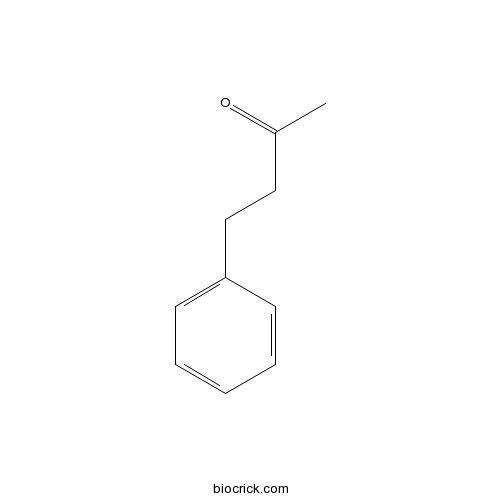4-Phenylbutan-2-oneCAS# 2550-26-7 |

Quality Control & MSDS
3D structure
Package In Stock
Number of papers citing our products

| Cas No. | 2550-26-7 | SDF | Download SDF |
| PubChem ID | 17355 | Appearance | Oil |
| Formula | C10H12O | M.Wt | 148.2 |
| Type of Compound | Phenols | Storage | Desiccate at -20°C |
| Solubility | Soluble in Chloroform,Dichloromethane,Ethyl Acetate,DMSO,Acetone,etc. | ||
| Chemical Name | 4-phenylbutan-2-one | ||
| SMILES | CC(=O)CCC1=CC=CC=C1 | ||
| Standard InChIKey | AKGGYBADQZYZPD-UHFFFAOYSA-N | ||
| General tips | For obtaining a higher solubility , please warm the tube at 37 ℃ and shake it in the ultrasonic bath for a while.Stock solution can be stored below -20℃ for several months. We recommend that you prepare and use the solution on the same day. However, if the test schedule requires, the stock solutions can be prepared in advance, and the stock solution must be sealed and stored below -20℃. In general, the stock solution can be kept for several months. Before use, we recommend that you leave the vial at room temperature for at least an hour before opening it. |
||
| About Packaging | 1. The packaging of the product may be reversed during transportation, cause the high purity compounds to adhere to the neck or cap of the vial.Take the vail out of its packaging and shake gently until the compounds fall to the bottom of the vial. 2. For liquid products, please centrifuge at 500xg to gather the liquid to the bottom of the vial. 3. Try to avoid loss or contamination during the experiment. |
||
| Shipping Condition | Packaging according to customer requirements(5mg, 10mg, 20mg and more). Ship via FedEx, DHL, UPS, EMS or other couriers with RT, or blue ice upon request. | ||
| Description | 4-Phenylbutan-2-one is a model compound for the preparation of fragrances. |
| Structure Identification | Phys Chem Chem Phys. 2011 Aug 14;13(30):13579-84.A smart palladium catalyst in ionic liquid for tandem processes.[Pubmed: 21750802 ]
|

4-Phenylbutan-2-one Dilution Calculator

4-Phenylbutan-2-one Molarity Calculator
| 1 mg | 5 mg | 10 mg | 20 mg | 25 mg | |
| 1 mM | 6.7476 mL | 33.7382 mL | 67.4764 mL | 134.9528 mL | 168.691 mL |
| 5 mM | 1.3495 mL | 6.7476 mL | 13.4953 mL | 26.9906 mL | 33.7382 mL |
| 10 mM | 0.6748 mL | 3.3738 mL | 6.7476 mL | 13.4953 mL | 16.8691 mL |
| 50 mM | 0.135 mL | 0.6748 mL | 1.3495 mL | 2.6991 mL | 3.3738 mL |
| 100 mM | 0.0675 mL | 0.3374 mL | 0.6748 mL | 1.3495 mL | 1.6869 mL |
| * Note: If you are in the process of experiment, it's necessary to make the dilution ratios of the samples. The dilution data above is only for reference. Normally, it's can get a better solubility within lower of Concentrations. | |||||

Calcutta University

University of Minnesota

University of Maryland School of Medicine

University of Illinois at Chicago

The Ohio State University

University of Zurich

Harvard University

Colorado State University

Auburn University

Yale University

Worcester Polytechnic Institute

Washington State University

Stanford University

University of Leipzig

Universidade da Beira Interior

The Institute of Cancer Research

Heidelberg University

University of Amsterdam

University of Auckland

TsingHua University

The University of Michigan

Miami University

DRURY University

Jilin University

Fudan University

Wuhan University

Sun Yat-sen University

Universite de Paris

Deemed University

Auckland University

The University of Tokyo

Korea University
- 3-Epioleanolic acid
Catalog No.:BCN3050
CAS No.:25499-90-5
- Tasquinimod
Catalog No.:BCC1987
CAS No.:254964-60-8
- 4-Allyloxy-2-hydroxybenzophenone
Catalog No.:BCC8675
CAS No.:2549-87-3
- Kushenol X
Catalog No.:BCN3350
CAS No.:254886-77-6
- Kushenol W
Catalog No.:BCN3307
CAS No.:254886-76-5
- 2,3-Bis(3,4-dimethoxybenzyl)butyrolactone
Catalog No.:BCN1473
CAS No.:25488-59-9
- Curryangine
Catalog No.:BCN7907
CAS No.:25488-37-3
- Talsupram hydrochloride
Catalog No.:BCC7924
CAS No.:25487-28-9
- Emricasan
Catalog No.:BCC5367
CAS No.:254750-02-2
- 2-MPPA
Catalog No.:BCC7995
CAS No.:254737-29-6
- Demethyleneberberine
Catalog No.:BCN2829
CAS No.:25459-91-0
- H-Asn-OtBu
Catalog No.:BCC2877
CAS No.:25456-86-4
- 1-Acetyl-4-piperidinecarboxylic acid
Catalog No.:BCC8447
CAS No.:25503-90-6
- Bruceine B
Catalog No.:BCN7615
CAS No.:25514-29-8
- Bruceine C
Catalog No.:BCN8000
CAS No.:25514-30-1
- Bruceine A
Catalog No.:BCC5311
CAS No.:25514-31-2
- Ibotenic acid
Catalog No.:BCC6591
CAS No.:2552-55-8
- Isoferulic acid
Catalog No.:BCN5122
CAS No.:25522-33-2
- Z-Ile-Glu-Pro-Phe-Ome
Catalog No.:BCC5526
CAS No.:255257-97-4
- Mayumbine
Catalog No.:BCN5123
CAS No.:25532-45-0
- Propidium iodide
Catalog No.:BCC8015
CAS No.:25535-16-4
- 1-(4-Hydroxybenzoyl)glucose
Catalog No.:BCN6900
CAS No.:25545-07-7
- 7-Methoxy-4-methylcoumarin
Catalog No.:BCN6540
CAS No.:2555-28-4
- Efetaal
Catalog No.:BCN8494
CAS No.:2556-10-7
A smart palladium catalyst in ionic liquid for tandem processes.[Pubmed:21750802]
Phys Chem Chem Phys. 2011 Aug 14;13(30):13579-84.
New catalytic systems based on in situ and preformed palladium nanoparticles in ionic liquids (characterised by TEM) starting from palladium acetate or dipalladiumtris(dibenzylideneacetone) have been applied in the synthesis of 4-Phenylbutan-2-one (II), a model compound for the preparation of fragrances. Imidazolium-based ionic liquid containing a methyl hydrogenophosphonate anion leads to an efficient Pd-catalyzed tandem coupling/reduction process, taking advantage of the multi-role of this solvent (nanoparticles stabiliser, base, hydrogen transfer agent). The influence of the mono-phosphine ligands (1-3) on the catalyst has been evaluated, showing that the ligand-free palladium system turns into the most appropriate for the formation of II using Pd(OAc)(2) as precursor. Fine-tuning conditions involved in this multi-parameter process have led us to propose a plausible mechanism based on the hydrogen transfer coming from the methyl hydrogenophosphonate anion.


